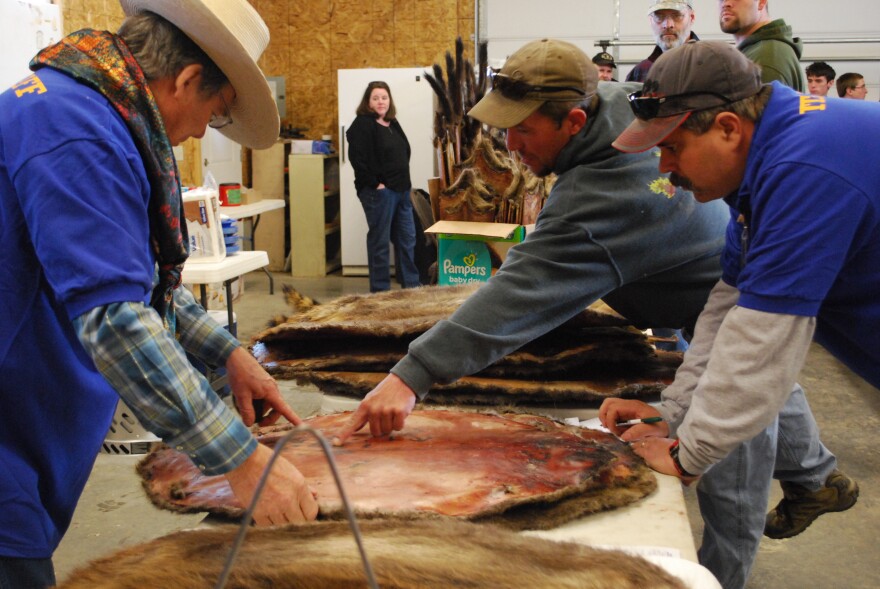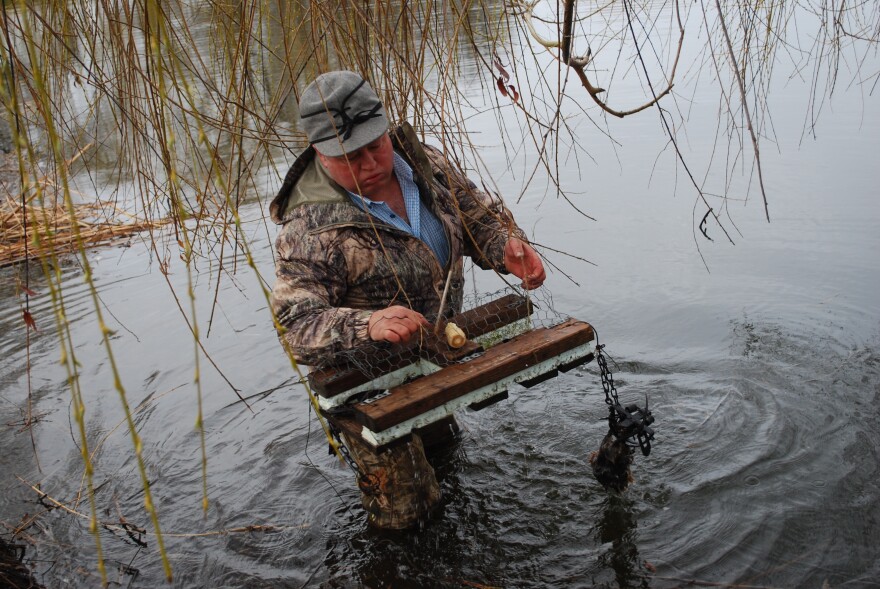Just four years ago, bobcat fur sold for about $200. Now, that same bobcat pelt can be sold for almost $2,000. Higher prices come from a rise in demand for fur in Asia, and it has led to more trappers in the field here in Idaho.
Patrick Carney, president of the Idaho Trappers Association, gets calls almost daily from folks who want advice on how to get into commercial trapping.
On a recent day in Eagle, Carney lets me tag along as he sets beaver traps in a neighborhood pond. You can see that beavers have been chewing on giant willow trees next to the pond in a gated community just west of Eagle. The property owner wants them gone, that’s why Carney is here.
He pulls on a pair of camouflage chest waders, steps into the pond and feels around the bank for the beaver den.
“It looks like from here on the ground, this is where he’s coming up,” Carney says as he slogs around in the pond. “You see where all the leaves are? I think I’ll put one there and one over here.”

Carney wades out of the water and heads to his blue Jetta where he pulls out half a dozen animal traps from his trunk. He walks backs to the pond and puts a few of the traps on the bank, sprinkling maraschino cherries around for bait. He also sets two traps in the water.
We return the next day to check the traps. Carney lifts his body-grip trap out of the water with a 30-pound dead beaver hanging from it.
Asian Demand Boosts Pelt Prices
Fur prices are at record highs. As the middle class has grown in places like China, Russia and Korea, more people have money to spend on luxuries like fur.
Reuters reports that consumers in China buy fur-trimmed backpacks and coats edged with fur. You can even buy mink-covered office supplies. The International Fur Trade Federation says the retail fur industry was worth more than $16 billion in 2012. That’s almost twice what it was 10 years ago.
One of the biggest exporters of fur is Toronto-based North American Fur Auctions. The company has more than 700 international buyers that attend its auctions. Trappers say that company pays them the highest prices for their furs.
In early March, the Idaho Trappers Association set up a fur pick-up day in Mountain Home. Men in camouflage brought their years’ haul of trapped animals, skinned, dried and ready to sell. The association collected more than 250 sacks of fur, a pile the size of a big SUV. Those pelts will be trucked to Canada for export.
Watching Idaho's Trapping Industry Grow
Steve Nadeau keeps a close eye on Idaho’s trapping industry. He set fur trapping rules for Idaho Fish and Game. His Boise office feels more like a cabin, with bear skulls on the filing cabinets and wolf, muskrat and pine martin pelts on the walls. He’s got charts of data that show the increase of trapping license sales over the last three years.
“We’ve gone from about 1,000 trappers statewide to just over 2,000,” Nadeau says. “And of course, a lot of trappers were hearing about the high-end pelt sales, you know, you might have gotten $1,000 for a really good pelt, so people were hearing that and getting excited and decided to get into trapping.”
Despite the increase, Nadeau says animal populations haven’t declined. Trapping limits have pretty much stayed the same.
“[It] probably [has] more to do with the doubling of trappers that aren’t very good out there,” says Nadeau.
The learning curve on trapping is steep, says Idaho Trappers Association President Patrick Carney. He points out that animals roam thousands of acres and trappers have to get them to put their paws in a tiny three-inch circle.
“The new trappers, number one, they don’t know how to trap like the older trappers,” says Carney. “And then they also, because they don’t know how to trap, their traps get froze down, they’re out more in the weather and they get froze down and an elephant couldn’t step on them and make them go off.”
Back at the fur pick-up day in Mountain Home, John Mattulat is taking it all in. He’s a hunter with no trapping experience.

Mattulat watches as one trapper brings in 375 muskrat. At $13-per-pelt, the guy walks away with almost $5,000. And that’s a pretty average haul.
Mattulat has hunted fur-bearing animals before, but he never thought he could make any money at it.
“Fur market prices were so depressed for so long that it didn’t make it worth the effort it takes to prepare a hide properly when compared to what I was spending in gas,” he says. “It really just didn’t justify the effort.”
What he’s seeing here is getting him interested in giving trapping a try. He’ll take the upcoming trapping seasons to hone his skill. He plans to be making money by this time next year.
Copyright 2014 Boise State Public Radio



